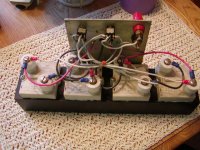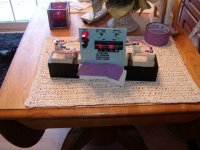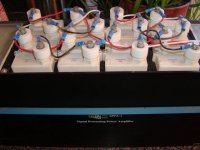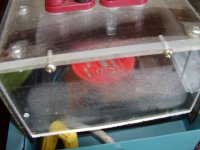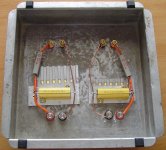Depends on which resistance you need and how much power you need.
For instance I am using 14 resistors in parallel, every resistor is 56ohm 10W to give me a load of 4ohm 140W.
When I use it for really high power I put the resistors in a can full of water. When you use 300W or more you see the water boiling
It is good for short power tests but of course not for continuous load at more than 50W.
For instance I am using 14 resistors in parallel, every resistor is 56ohm 10W to give me a load of 4ohm 140W.
When I use it for really high power I put the resistors in a can full of water. When you use 300W or more you see the water boiling

It is good for short power tests but of course not for continuous load at more than 50W.
Picture of big load
4 EBG 600 watt load resistors per channel in a series parallel for a 4 ohm load per channel. The unit can also be used as one massive 8 ohm load if needed for large bridge amplifiers. It is cooled by 3) 5" Dayton 70 CFM fans and never gets warm no matter what.
4 EBG 600 watt load resistors per channel in a series parallel for a 4 ohm load per channel. The unit can also be used as one massive 8 ohm load if needed for large bridge amplifiers. It is cooled by 3) 5" Dayton 70 CFM fans and never gets warm no matter what.
Attachments
UXP SERIES Power Resistor
EBG has developed a small unique package (60 mm x 65 mm) that can handle up to 960 Watts continuously when mounted to a heatsink with a bottom case temperature of 70°C at full power. They have 3 different models available; 300W, 600W, and 800W, all using the same unique packaging. The catalog power ratings are all shown for an 85°C bottom case temp, however if you are able to keep the bottom case at 70°C you can acheive a 20% increase in the continuous power capability. This resistor was designed for the high-speed trains in Europe, but is one of the fastest growing lines here in North America. This patented package offers electrical advantages as well as physical advantages. The ohmic value range begins at 0.5R up to 1M. The dielectric strength can go as high as 12 kVrms and the partial discharge up to 7kVrms < 10pC for 30 seconds. Although the standard terminal heights are offset at 30mm and 32mm there are many other terminal heights and options available. Easy mounting with 2 screws to the heatsink is also an advantage to our UXP series as it has an internal calabration to apply equal pressure to the heatsink with only those 2 mounting screws. This thick film resistor can save your company time and money. Check their detailed spec sheet or call them for many additional options not listed.
--------------------------------------------------------------------------------
EBG has developed a small unique package (60 mm x 65 mm) that can handle up to 960 Watts continuously when mounted to a heatsink with a bottom case temperature of 70°C at full power. They have 3 different models available; 300W, 600W, and 800W, all using the same unique packaging. The catalog power ratings are all shown for an 85°C bottom case temp, however if you are able to keep the bottom case at 70°C you can acheive a 20% increase in the continuous power capability. This resistor was designed for the high-speed trains in Europe, but is one of the fastest growing lines here in North America. This patented package offers electrical advantages as well as physical advantages. The ohmic value range begins at 0.5R up to 1M. The dielectric strength can go as high as 12 kVrms and the partial discharge up to 7kVrms < 10pC for 30 seconds. Although the standard terminal heights are offset at 30mm and 32mm there are many other terminal heights and options available. Easy mounting with 2 screws to the heatsink is also an advantage to our UXP series as it has an internal calabration to apply equal pressure to the heatsink with only those 2 mounting screws. This thick film resistor can save your company time and money. Check their detailed spec sheet or call them for many additional options not listed.
--------------------------------------------------------------------------------
hi, What do these resistors cost?
I bought mine surplus from Skycraft in Florida a few years back for $4 ea.
I just finished checking and they don't carry them now.
My "small" dummy load:
http://it.geocities.com/fabiobonotto/CIRCUITI/DummyLoad.htm
(page in italian only, but schematic is "universal" )
)
http://it.geocities.com/fabiobonotto/CIRCUITI/DummyLoad.htm
(page in italian only, but schematic is "universal"
acid_k2 said:My "small" dummy load:
http://it.geocities.com/fabiobonotto/CIRCUITI/DummyLoad.htm
(page in italian only, but schematic is "universal")
Why do you have that parallel diode in there? The way your schematic is right now, if you turn the pot until the wiper is towards the top in reference to the diagram, you're shorting out half the output wave right through the pot and diode!
Here is my small (50W) DIY Speaker Dummy Load. With this config, you can also hook up a speaker to monitor your test. Capacitance and inductance can also be added to the test using the binding posts.
Attachments
Bonsai said:You can also use electric kettle elements. Typically about 2 2 Ohms, so is you wire 3 in parallel you get 7.3 Ohms.
Good for about 6KW when immersed in Water

You don't mean that, do you? Should be SERIES connected.
mag said:Depends on which resistance you need and how much power you need.
For instance I am using 14 resistors in parallel, every resistor is 56ohm 10W to give me a load of 4ohm 140W.
When I use it for really high power I put the resistors in a can full of water. When you use 300W or more you see the water boiling
It is good for short power tests but of course not for continuous load at more than 50W.
same thing as I did but I used 2 sets of 15x56R so I have two 3.7R loads. if an amp survives 3.7R, 4ohms would be easy.
An externally hosted image should be here but it was not working when we last tested it.
I used to have a similar setup years ago, with a dual network for 2x8R or 1x4R in a large plastic keg full of water.AndrewT said:220Vac & 22r gives about 2kW.
Three in parallel will be around 7r3.
Might be a bit lower if you only push in 200W though.
I need a new test load capable of high power, so I think I'll use conventional high power resitors, heatsinks and a fan as the old fashioned jug elements aren't as conventiently available as in the past.
- Status
- This old topic is closed. If you want to reopen this topic, contact a moderator using the "Report Post" button.
- Home
- Amplifiers
- Solid State
- dummy load
